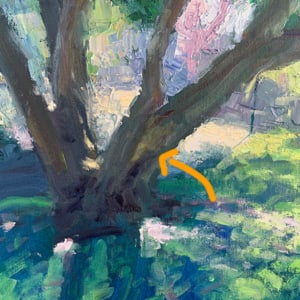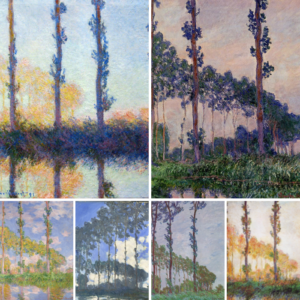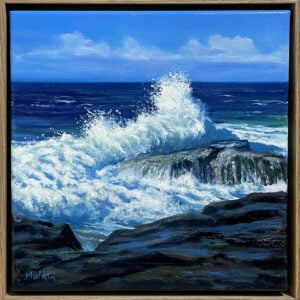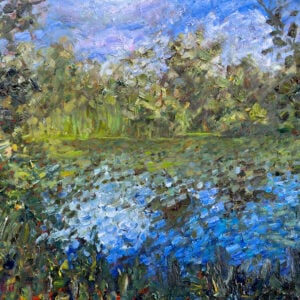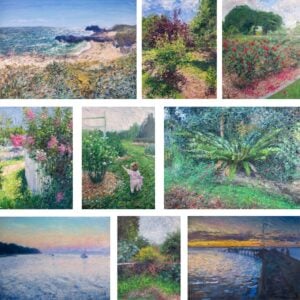(My “On the Easel” posts give you a behind-the-scenes look at what I am working on, what went well, what went wrong, and things I learn.)
Let’s take a look at how I painted Gumdale, Red Flowers, Blue Sky. I run past this spot almost every day. On this particular occasion, everything was just right. The sun, the colors, composition, clouds, flowers… everything. It was one of those double-take moments where I had to backtrack and take a few photos to paint in the studio.

Reference Photo
Below is the reference photo I painted from. Feel free to paint it yourself.

You can download a high-resolution version of the photo here.
Supplies
Here’s what I used:
- Oil on Ambersand gessoboard, 9 by 12 inches.
- Main colors: Ultramarine blue, cobalt blue, cadmium red, magenta, cadmium yellow, cadmium yellow light, viridian green, and titanium white.
Refer to my supplies list for more details.
Notes and Lessons Learned
- I didn’t have big plans for this painting. It was really just to get me out of a creative rut and to get some ideas and inspiration flowing.
Tip: The best way to break out of a creative rut is to paint something, anything. This will lead to more activity and inspiration. Whatever you do, don’t let your easel lay dormant for too long, or procrastination might get the better of you.
- I painted not long after taking the reference photo, whilst my first impressions were still fresh in my head. When I paint from reference photos like this, I use the photo as a general guide and rely more on my memories and impressions of the subject.
- The reference photo doesn’t do the scene justice. The colors were much richer and brighter in person.
- A key feature of the painting is the striking contrast between the red flowers and the green grass and leaves. Red and green are complementary colors, meaning they are on opposing sides of the color wheel and have a natural contrast. The blue sky is weaker in saturation and plays more of a support role in the painting.
- I took the photo at midday when the sun was bright and high in the sky. Under the midday sun, there tends to be a sharp contrast between light and dark, hard edges, and high clarity.
Tip: It’s important to understand the nature and conditions of the subject so you can play into these ideas in your painting. In this case, it’s midday with a blue sky and a few clouds. I played into this by using hard edges, more detailed brushwork, and sharp color contrast. If, on the other hand, it was an overcast and rainy day, I would use softer edges and contrast.
Progress Shots
Step 1: Sketch the major shapes and lines.

Step 2: Block in the general colors and shapes. I used paper towel to lift excess paint from the surface. I find the surface becomes less responsive to my strokes as paint builds up.

Step 3: Consolidate the trees, leaves, flowers, fence, and ground. I used more texture and visible brushwork for the leaves and flowers shooting up over the top of the fence, as this is the focal point of the painting.

Step 4: Add detail and texture to the grass. Notice my upward brushwork that plays into the idea of fresh-cut grass.

Step 5: Work on the sky, add stronger shadows to the fence, and finish off the road and path with a few palette knife strokes.

Step 6: Make a few adjustments here and there, then sign and photograph the finished painting.

Thanks for Reading!
I appreciate you taking the time to read this post and I hope you found it helpful. Feel free to share it with friends. If you want to learn more, make sure to check out my Landscape Painting Masterclass. Enrollment is open for the next week.
Happy painting!
Dan Scott

Draw Paint Academy

